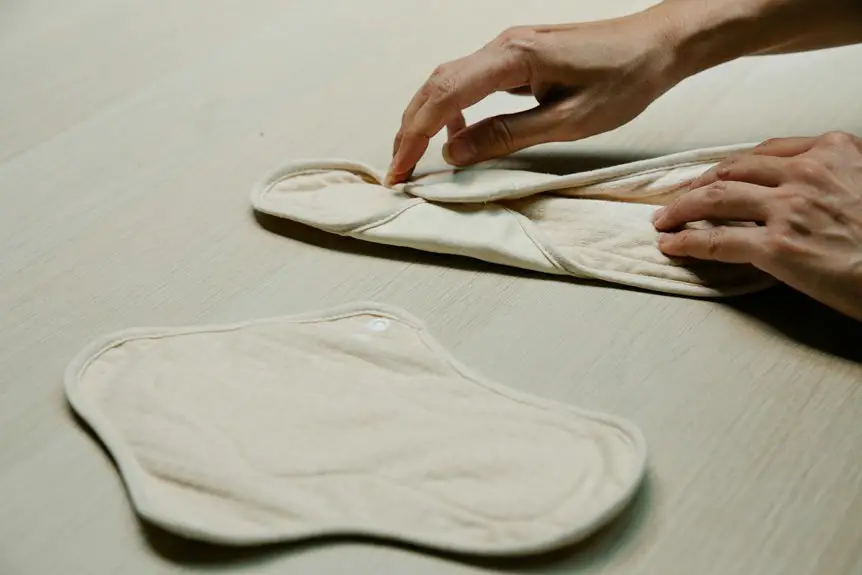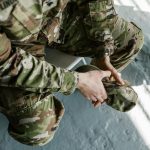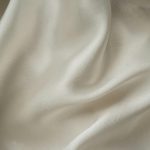You rely on Kevlar K29 fabric because it’s incredibly strong, lightweight, and heat resistant—perfect for stopping bullets, cuts, and impacts. Its tightly packed polymer chains give it unmatched durability, making it a top choice in protective gear like vests, helmets, and gloves. Manufactured through precise spinning and weaving, it enhances your safety without sacrificing comfort. If you want to understand how this fabric revolutionizes protection and what innovations lie ahead, keep exploring its story and capabilities.
Table of Contents
Key Takeaways
- Kevlar K29 fabric is renowned for its exceptional tensile strength and impact resistance, making it ideal for bulletproof vests and protective gear.
- Its chemical structure features tightly packed polymer chains with strong hydrogen bonds, providing durability and resistance to stretching and heat up to 450°C.
- Manufacturing involves polymerization, wet spinning, fiber stretching, and weaving, ensuring high strength, uniformity, and enhanced environmental resistance.
- Used extensively in industrial safety gear like cut-resistant gloves, helmets, and protective sleeves to shield workers from sharp tools and hazardous materials.
- Future innovations include integrating carbon nanotubes and smart textiles for real-time damage monitoring, adaptive protection, and improved comfort and flexibility.
History and Development of Kevlar K29
Although you mightn’t realize it, Kevlar K29 has a fascinating history that dates back to the 1960s when Stephanie Kwolek, a chemist at DuPont, discovered this strong synthetic fiber.
You can appreciate how her breakthrough came from experimenting with liquid crystalline polymers, which led to Kevlar’s exceptional strength-to-weight ratio.
When DuPont commercialized Kevlar, you saw it quickly adopted for protective gear, revolutionizing personal safety.
Over the years, Kevlar K29 became known for its durability and resistance to impact, making it ideal for bulletproof vests and helmets.
As you learn about Kevlar K29, you’ll notice how its development reflects innovation driven by necessity—keeping people safer in hazardous environments.
Understanding this origin helps you grasp why Kevlar remains essential in modern protection solutions.
Chemical and Physical Properties of Kevlar K29
Kevlar K29’s remarkable strength stems from its unique chemical structure and physical characteristics.
When you look at its molecular makeup, you’ll find tightly packed polymer chains linked by strong hydrogen bonds, which give it incredible tensile strength and resistance to stretching.
Physically, Kevlar K29 fibers are lightweight yet highly durable, offering excellent impact resistance without adding bulk.
Kevlar K29 fibers combine lightweight design with high durability to provide superior impact resistance without extra weight.
You’ll also notice its high thermal stability—Kevlar K29 can withstand temperatures up to around 450°C without degrading. This makes it ideal for protective gear exposed to heat or friction.
Plus, it resists chemical corrosion, so it won’t break down easily when exposed to acids or solvents.
These combined properties guarantee that Kevlar K29 delivers the performance you need in demanding protective applications.
Manufacturing Process of Kevlar K29 Fabric
When you immerse yourself in making K29 fabric, the process starts with carefully controlled polymerization to create the strong aramid fibers. You dissolve monomers in a solvent, initiating a reaction that forms long molecular chains with high tensile strength.
Next, you spin these polymer solutions into fibers through a process called wet spinning, forcing them through tiny spinnerets into an acidic bath that solidifies the filaments. Afterward, you stretch the fibers to align the molecules, boosting strength and durability.
Once the fibers are ready, you weave them into fabric using precise looms, maintaining consistent tension to guarantee uniformity. Finally, you treat the fabric with finishing agents to enhance its resistance to heat and environmental factors, resulting in the high-performance Kevlar K29 fabric you rely on for protection.
Applications in Personal Protective Equipment
When you wear ballistic vests made with Kevlar K29 fabric, you benefit from exceptional protection against bullets and shrapnel.
You’ll also appreciate its impact resistance, which helps absorb and disperse energy to reduce injury.
Let’s explore how these features make Kevlar K29 a top choice in personal protective equipment.
Ballistic Vests Benefits
A ballistic vest can considerably enhance your safety by providing reliable protection against bullets and shrapnel.
When you wear one made with Kevlar K29 fabric, you benefit from its lightweight strength, which lets you move freely without feeling weighed down. This fabric’s high tensile strength means it can stop multiple rounds, helping you stay protected in dangerous situations.
You’ll also appreciate its durability; Kevlar K29 resists wear and tear, ensuring your vest remains effective over time. Plus, its flexibility adapts to your body shape, giving you comfort during extended use.
Impact Resistance Features
Beyond ballistic vests, Kevlar K29 fabric plays an essential role in enhancing impact resistance across various personal protective equipment (PPE).
When you wear gear made with this fabric, you get superior protection against blunt force trauma and sharp objects.
Here’s how Kevlar K29 boosts impact resistance in PPE:
- Helmets: It helps absorb and disperse impact energy, reducing the risk of head injuries.
- Gloves: The fabric resists cuts and punctures, keeping your hands safe without sacrificing flexibility.
- Protective sleeves and aprons: Kevlar K29 shields your arms and torso from impacts and abrasions in hazardous environments.
Industrial Uses and Safety Enhancements
You rely on Kevlar K29 fabric to boost industrial safety by protecting workers from sharp tools and hazardous materials.
Its strength and durability make it ideal for gear that withstands tough conditions.
Let’s explore how this fabric enhances safety in demanding work environments.
Industrial Safety Applications
When working in hazardous industrial environments, Kevlar K29 fabric greatly boosts your safety by providing reliable protection against cuts, abrasions, and heat.
You’ll find it ideal for creating gear that stands up to tough conditions, keeping you secure without sacrificing comfort.
Here are key industrial safety applications where Kevlar K29 excels:
- Cut-resistant gloves – Protect your hands from sharp tools and metal edges during manufacturing or assembly tasks.
- Protective sleeves and aprons – Shield your arms and torso from sparks, heat, and rough surfaces in welding or metalworking.
- Reinforced safety clothing – Enhance durability and resistance in uniforms used by electrical or chemical plant workers.
Using Kevlar K29 fabric in these ways helps you maintain safety and confidence while on the job.
Enhancing Worker Protection
Worker protection improves markedly with Kevlar K29 fabric, which combines strength and flexibility to meet industrial safety demands.
When you wear gear made from this material, you get excellent cut resistance and impact absorption without sacrificing mobility. Kevlar K29 gloves, sleeves, and aprons shield you from sharp tools and flying debris, reducing injury risks on the job.
Its heat resistance also protects you during welding or high-temperature tasks. Because the fabric is lightweight and breathable, you stay comfortable throughout long shifts, keeping focus sharp and fatigue low.
By integrating Kevlar K29 into your personal protective equipment, you enhance safety without compromising performance, allowing you to work confidently in hazardous environments.
This fabric truly sets a new standard for worker protection across industries.
Comparing Kevlar K29 to Other Protective Fabrics
Although many protective fabrics are available, Kevlar K29 stands out for its unique balance of strength, flexibility, and lightweight properties.
When you compare it to other materials, you’ll notice key differences that make it ideal for various protective applications.
For instance:
- Dyneema offers excellent cut resistance and is lighter, but it lacks Kevlar’s heat resistance.
- Nomex excels in thermal protection but doesn’t provide the same tensile strength or cut resistance.
- Spectra is similar in strength to Kevlar but is less flexible, which can limit comfort.
Future Innovations and Emerging Technologies in Kevlar Use
As technology advances, Kevlar K29 continues to evolve, unfastening new possibilities for protection and performance.
You’ll see innovations like nanotechnology enhancing Kevlar fibers, making them lighter and stronger without sacrificing durability. Researchers are also exploring hybrid composites, combining Kevlar with graphene or carbon nanotubes to boost impact resistance and flexibility.
Smart textiles are another exciting frontier; imagine Kevlar fabrics embedded with sensors that monitor damage or environmental threats in real time. These emerging technologies mean you’ll soon wear protective gear that adapts to conditions, improving safety and comfort simultaneously.
Kevlar fabrics with embedded sensors will monitor threats and damage, adapting protection for enhanced safety and comfort.
As these advancements develop, Kevlar K29 won’t just protect you—it’ll actively enhance your situational awareness and resilience in challenging environments. Staying informed will help you choose gear that leverages these cutting-edge improvements.
Frequently Asked Questions
How Should Kevlar K29 Fabric Be Cleaned and Maintained?
You should gently hand wash Kevlar K29 fabric with mild soap and cold water. Avoid bleach or harsh chemicals. Let it air dry away from direct sunlight to maintain its strength and protective qualities effectively.
Can Kevlar K29 Fabric Be Recycled or Reused?
You’d think such a tough fabric would be a recycling dream, right? Actually, recycling Kevlar K29 is tricky, but you can reuse it creatively in gear or crafts, extending its life instead of tossing it away.
Is Kevlar K29 Fabric Hypoallergenic or Safe for Sensitive Skin?
You’ll find Kevlar K29 fabric generally safe for sensitive skin since it’s synthetic and doesn’t typically cause allergies. However, some people might experience irritation from the fabric’s texture or treatment chemicals, so test it first.
What Are the Environmental Impacts of Producing Kevlar K29?
You’ll find producing Kevlar K29 consumes significant energy and chemicals, which can impact air and water quality. However, its durability reduces waste by extending product life, balancing some environmental concerns effectively.
How Does Kevlar K29 React to Extreme Weather Conditions?
Like a steadfast guardian, Kevlar K29 resists extreme weather well. You’ll find it holds strong against heat, cold, and moisture without losing strength, but prolonged UV exposure can weaken its fibers over time, so protect it accordingly.
- Tetron Fabric for Marine Applications: Durability and Use Cases - June 18, 2025
- Tetron Fabric for Outdoor Furniture: Weather Resistance and Care - June 18, 2025
- Tetron Fabric for Wall Coverings: Style and Application Tips - June 18, 2025







